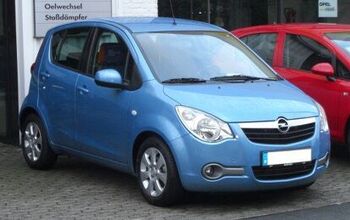The UAW: Cut and Run?
I wouldn’t join any union that would have me as a member. And yet the United Autoworker’s Union (UAW) wants me. Yep, UAW Local 1981 represents freelance writers. The pen-pushing Local is part of a growing trend within the UAW. As more and more of their members accept buyouts and early retirements, as the UAW [secretly] realizes that they’ve milked their Detroit cash cow to the point of death, the union is pulling a Studebaker. They’re diversifying out of their core business before their core business goes tango uniform.
The UAW was formed in 1935. In 1969, membership peaked at roughly 1.5m members. By 2002, 639k industry workers were paying UAW dues. By 2005, the number sank to 557K members. After the next round of “attrition plans” from GM, Ford, and Delphi, there’ll be fewer than a half million active UAW members left. The exodus occurs against a backdrop of a general decline in the “market” for union representation. According to the US Bureau of Labor Statistics, national union membership has dropped from 20.1% of the U.S. labor force in 1983, to 12.5% in 2005.
What’s worse, some union members are beginning to question the UAW’s efficacy. Speaking to The Detroit Free Press, one Ford employee opting for early retirement noted "it would be belaboring the obvious to say that the UAW's nuclear option of a strike is not as evident as it used to be." If members believe the UAW has “gone soft,” labor leaders negotiating next year’s contract will be between a rock (breakaway dissent, wildcat strikes and a potential fall from power) and a hard place (clinging to contracts that kill the golden goose). Bet on Plan B.
Like many other experts, labor law expert Jim Hendricks doesn’t see it that way. "I don't think they can survive the way they used to. Manufacturers and employers feared this union because of their sheer size and strength." Hendricks thinks the UAW should merge with other unions facing the same problems. While UAW leadership hasn't ruled out the possibility, they seem more interested in conquering new territory on their own.
In the short term, the UAW faces the same problem as The Big Two Point Five: they’ll soon have more retirees than active employees. Like any clued-in capitalist, the UAW’s management knows they have to grow to keep the cash flowing. Logically enough, the UAW has spread their recruitment efforts throughout the rest of the automotive industry, including auto parts and heavy truck manufacturers and auto dealerships (mechanics and back office staff).
At the same time, the UAW is scrambling to organize any group that’s not already represented by some other labor union (and edging into some areas which already are). So far they’ve established a presence in household appliances, brewing, lawn/garden equipment, tools and hardware, firearms, boats, modular housing, toys, musical instruments, pharmaceuticals, cosmetics, food processing, public radio stations, casinos, aerospace and defense.
The UAW has also cast their net over a wide range of professions: draftsmen, industrial designers, engineers, computer specialists, health care professionals, journalists and writers, curators and librarians, graduate teaching assistants and staff lawyers.
Most promisingly of all– given the taxpayer’s seemingly limitless purse and any union’s ability to use political muscle to wrest financial concessions– the UAW is organizing state and local government employees, such as social service workers. Their latest conquest: Michigan’s home-based child care providers. So far, the UAW reports it’s organized about some 40k care providers.
And yet the UAW claims they’re being selective about potential members. UAW Secretary-Treasurer Elizabeth Bunn stated, "We are not interested in representing workers where we don't feel we can act as a powerful voice for them." Translation? Unless you’re in an industry where the UAW has a chance of establishing a stronghold or getting a lot of (dues-paying) members, fuhgeddaboudit!
With the UAW dividing its attention amongst these diverse areas, how can they successfully address the labor issues of any of their smaller constituent groups? Can an organization where the leadership has focused on workers in one single industry for the past 70 years effectively advocate for other totally unrelated industries?
The needs and concerns of nurses and lawyers aren’t necessarily the same as those of assembly line workers, and you can’t take the same actions against government entities that you can against giant corporations. Is the UAW equipped to handle this diversity, or are they bloating their portfolio beyond any rational hope of quality, GM-style?
If successful, the UAW’s expansion is a major threat to domestic automakers. It will strengthen the only power that any negotiator ever possesses: the power to walk away. In fact, the more industries with UAW representation, the more the union needs to look tough. Autoworkers, indeed the entire domestic automobile industry, could be sacrificed on the altar of the union’s long term survival strategy.
More by Frank Williams
Latest Car Reviews
Read moreLatest Product Reviews
Read moreRecent Comments
- 28-Cars-Later Why RHO? Were Gamma and Epsilon already taken?
- 28-Cars-Later "The VF 8 has struggled to break ground in the increasingly crowded EV market, as spotty reviews have highlighted deficiencies with its tech, ride quality, and driver assistance features. That said, the price isn’t terrible by current EV standards, starting at $47,200 with leases at $429 monthly." In a not so surprising turn of events, VinFast US has already gone bankrupt.
- 28-Cars-Later "Farley expressed his belief that Ford would figure things out in the next few years."Ford death watch starts now.
- JMII My wife's next car will be an EV. As long as it costs under $42k that is totally within our budget. The average cost of a new ICE car is... (checks interwebs) = $47k. So EVs are already in the "affordable" range for today's new car buyers.We already have two other ICE vehicles one of which has a 6.2l V8 with a manual. This way we can have our cake and eat it too. If your a one vehicle household I can see why an EV, no matter the cost, may not work in that situation. But if you have two vehicles one can easily be an EV.My brother has an EV (Tesla Model Y) along with two ICE Porsche's (one is a dedicated track car) and his high school age daughters share an EV (Bolt). I fully assume his daughters will never drive an ICE vehicle. Just like they have never watched anything but HiDef TV, never used a land-line, nor been without an iPad. To them the concept of an ICE power vehicle is complete ridiculous - you mean you have to STOP driving to put some gas in and then PAY for it!!! Why? the car should already charged and the cost is covered by just paying the monthly electric bill.So the way I see it the EV problem will solve itself, once all the boomers die off. Myself as part of Gen X / MTV Generation will have drive a mix of EV and ICE.
- 28-Cars-Later [Model year is 2010] "and mileage is 144,000"Why not ask $25,000? Oh too cheap, how about $50,000?Wait... the circus is missing one clown, please report to wardrobe. 2010 AUDI A3 AWD 4D HATCHBACK PREMIUM PLUS


































Comments
Join the conversation
And I don't believe for one minute that the UAW is responsible for what has befallen the US auto industry. Like Henry Ford, I also believe that workers need to be paid a living wage so that they are able to buy the products they produce. But like skyrocketing CEO salaries, paying an employee $100,000 a year to push a broom (that's a metaphor) is equally unreasonable. The fact is that business in the US only reacts to crisis. The idea here has always been to get as much as I can and everyone else be damned, regardless of the consequences. Even if you were to implement drastic strategies that would make imports uncompetitive on price, history has shown us that all the domestic manufactures would do is raise their prices to just under what the imports sell at. That goes for all industries, not just automotive.
Government to the rescue...... http://www.lewrockwell.com/suprynowicz/suprynowicz55.html